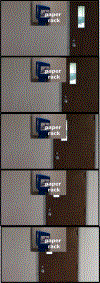Age differences in spatial memory for mediated environments
- PMID: 30124308
- PMCID: PMC8718108
- DOI: 10.1037/pag0000286
Age differences in spatial memory for mediated environments
Abstract
Compared with younger adults, older adults have more difficulty with navigation and spatial memory in both familiar and unfamiliar domains. However, the cognitive mechanisms underlying these effects have been little explored. We examined three potential factors: (a) use of and coordination across spatial reference frames, (b) nonspatial cognitive abilities, and (c) the ability to segment a route into effective chunks. In two experiments, healthy young and older adults watched videos of navigation in a novel environment and had to remember the placement of landmarks along the route. Participants completed three spatial memory tasks-a virtual pointing task, a distance estimation task, and sketch map drawing-for each route. The pointing task depends on updating and accessing the updated egocentric reference frame relative to other frames. Map drawing may rely more on environment-centered processing. The distance estimation task could be solved using either frame of reference. Last, participants segmented each route. In a separate session, working memory, processing speed, and verbal memory were assessed. Older adults performed less well on all spatial tasks compared with younger adults; aging had a stronger negative effect on pointing performance. This may point to impairments in older adults' ability to update and coordinate information across reference frames. Performance on all spatial tasks was predicted by nonspatial task performance. Segmentation did not predict spatial memory. These results underline the importance of situating age differences in navigation in the context of basic transformations of spatial reference frames, and also in the context of nonspatial cognitive abilities. (PsycINFO Database Record
(c) 2018 APA, all rights reserved).
Figures



References
-
- Bates D, Mächler M, Bolker B, & Walker S (2015). Fitting linear mixed-effects models using lme4. Journal of Statistical Software, 67(1). 10.18637/jss.v067.i01 - DOI
-
- Conway A, Kane M, Bunting M, Hambrick D, Wilhelm O, & Engle R (2005). Working memory span tasks: A methodological review and user’s guide. Psychonomic Bulletin & Review, 12(5), 769–786. - PubMed
MeSH terms
Grants and funding
LinkOut - more resources
Full Text Sources
Other Literature Sources
Medical

